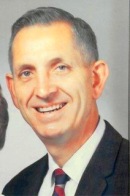

The Hewlett Packard Geiger Counter
by Earle Rother, Jr. September 30, 2017
Editor Note:
The author is the son of HP's first paymaster, Earle Rother. In the post-WWII period, HP was struggling to deal with some excess personnel, caused by the cutback in military-related business. The organization was thin, no formal org charts, finance work was handled by just a small group, including Earle and Frank Cavier, the face of accounting and finance, a fairly unsophisticated beginning. Earle's son, Earle Jr. was intrigued when browsing this website, and seeing the innovation culture of 1950s HP. He was especially interested in an artifact sitting under the workbench in his garage, left over from his father's HP career. It was a Geiger Counter, a product well known to US citizens as the atomic age dawned on us after the Pacific Ocean test at Bikini. Nuclear science was now moving into civilian applications at the same time the Pentagon was racing ahead with hydrogen bombs and more efficient fission bombs. We can guess that after Bill and Dave might have considered a new Geiger Counter product for nuclear measurements, that once they found other electronic products like frequency counters would have broader markets, that this prototype would have been available for Rother to take home as a scientific curiosity. |
We are reminded of the Nuclear Age

|
Earle Rother First HP Paymaster |

|
The prototype HP Geiger Counter, circa 1950.
|

|
The battery complement: Four "D" Cells, two large 67.5, two 22.5 volt DC. Remember that internal circuitry would have been vacuum tubes. |
On August 8, 2017, we awoke to the news that North Korea has successfully produced a miniaturized nuclear warhead that can fit inside its missiles. This is like the dawn of the atomic age and the cold war all over again, just like in the fifties. I remembered, when I cleaned out my father's garage after he passed away in 2007, that I had inherited a Hewlett Packard Geiger Counter.
I rummaged around in my garage and found the dusty device on the floor under a workbench, where I had placed it 10 years ago. Before "storing" it on the floor, I had removed the batteries from the attached battery box to avoid leakage. I was amazed that the old batteries hadn't already corroded and leaked inside the box. I rummaged around some more to find the batteries. I didn't throw them away because they were old Burgess batteries, four of which were odd voltages, and there might be a chance to get replacements.

|
Geiger Counter with open Battery Box and Batteries.
|
After locating the Geiger counter and batteries, I decided to do a Google search for it to find out more information, especially about the sensor cell. What type of sensor cell? Would it still function? Was it still workable?
A number of related websites appeared but none that helped me determine any more information about the counter other than what I remembered when my father originally brought it to our home in Los Altos nearly 70 years ago. I did find a short excerpt in the book "Bill & Dave: How Hewlett and Packard Built the World's Greatest Company" by Michael S. Malone, but little else.

|
Pages 132 & 133 of Chapter 4, The HP Way.
|
Since the device was produced long before the Internet and since it never became an HP production product, no specific information about it showed up in the search. It is obvious that the counter is a prototype as no HP logo or instrument designator is found anywhere on the outside. Also, the battery holder array is just stuffed into a suitable sized box, not the professional HP way.
So on August 9, 2017, the old Geiger counter still sits on my workbench, somewhat dirty and corroded, non-functioning because of long-dead batteries and uncertainty about whether or not the sensor cell (whatever type it is) still functions.
Earle Rother, Jr. Son of Hewlett Packard's first paymaster. Sept 30, 2017

|
Radiation intensity dial, milli-Roentgen per hour.
|

|
Power and range switch.
|

|
Mode and calibration.
|

|
The configuration seems a bit clumsy, compared to future competitive designs (below)
|

|
Current models available on E-Bay, these designs were called Radiac in the 1960s. |

